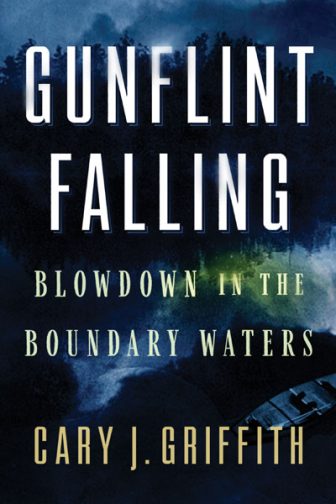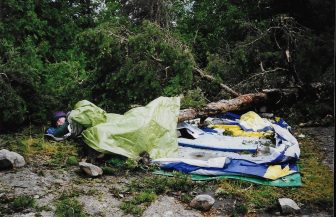
A 1999 derecho sped through the Boundary Waters Canoe Area Wilderness at upwards of 80 miles per hour, knocking down over 48 million trees. Image: National Weather Service
By Daniel Schoenherr
On July 2, 1999, 38-year-old Vicky Brockman set out with two friends down the Boundary Waters Canoe Area Wilderness’s Gunflint Trail in Minnesota.
Three days later, the group was stranded in the center of a storm with the strength of a hurricane. They rushed into their tents for shelter.
Brockman curled on her side, her knees at her chest. Raindrops hit the tent like bullets. She froze in terror as she listened to the wind tear trees apart outside. A nearby pine split, landing directly on top of her. She was pinned to the ground with a broken pelvis. Help was dozens of miles away.

The cover for Gunflint Falling: Blowdown in the Boundary Waters, written by Cary J Griffith.
Brockman was one of 60 people in the Boundary Waters injured during what is known as a blowdown — a storm where a large number of trees are downed by wind. Miraculously, nobody was killed. Brockman was one of many who told their story of survival in Cary J Griffith’s Gunflint Falling: Blowdown in the Boundary Waters, published in December.
They are stories that could become more common in the Great Lakes region as such storms increasingly form further north due to a shifting climate, say experts who also warn that preparation is the key to safety.
The 1999 storm destroyed millions of trees and caused billions of dollars in damage to the towns it blew through. Although a derecho storm is only about the size of a small city, it can travel for thousands of miles while losing little energy.
The Boundary Waters blowdown is one of the largest natural disasters to impact the Midwest in the past century — and it’s more important than ever to tell its story, Griffith said.
“I kind of look at the blowdown as one of the first salvos, one of the first extreme climate events that we’ve been beset by,” he said. “It was a significant event, but I think one of the reasons people haven’t heard about it is because we have had so many significant weather events.”
Griffith has written eight fiction and nonfiction books set in Minnesota. His love for the Boundary Waters started in the ninth grade, when he first visited the area in the northeast corner of the state along the Canadian border. He was struck by the beauty of the wildlife inhabiting the million-acre wilderness area’s deep forests and sprawling lakes.

Cary J Griffith, the author of Gunflint Falling: Blowdown in the Boundary Waters, writes books about Minnesota’s wilderness. Image: Cary J Griffith
Griffith’s passion for the area burns more than 50 years later. He was devastated by the blowdown, and decided to capture the pivotal moment of the region’s ecological change.
In addition to documenting eyewitness accounts of the damage, Gunflint Falling explores the factors leading to the storm and its aftermath. Griffith discovered that derechos and other similar weather events are starting to “creep north,” having become more frequent in the upper Midwest over the past 50 years.
“A lot of them happened around (July) in the heart of summer, but they seldom reach that far north,” he said. ”And that is beginning to change.”
Derechos have since hit other towns, causing even more damage, he said. In 2020, Cedar Rapids, Iowa was leveled by a derecho with wind speeds of 140 miles per hour and causing $7.5 billion in damage. The National Oceanic and Atmospheric Administration labeled it as the “most costly thunderstorm in U.S. history.”

Vicky Brockman was one of 60 people in Minnesota’s Boundary Waters Canoe Area Wilderness injured by falling trees as the result of a fast-moving storm, called a derecho. The storm traveled 1,300 miles to the Atlantic coast and killed one person in Maine. Image: Cary J Griffith, U.S. Forest Service
The 2020 derecho didn’t make many headlines. Coverage of the disaster was overshadowed by an explosion in Beirut six days earlier. People “just aren’t paying attention” to derechos, Griffith said.
“Those significant events are increasing in regularity and they’re climbing north. But we’re kind of becoming inured of them just because of their frequency,” he said. A derecho forms in the Midwest about once a year, with variable strength.
And the region is becoming more prepared for these storms, said Joseph Moore, a warning coordination meteorologist for the National Weather Service in Duluth.
Advancements in weather prediction technology since the ‘99 derecho would better keep people out of harm, Moore said. Although the severity of a derecho is still hard to predict, hikers planning to be off-the-grid would know about incoming storms more than a week in advance.
“A lot of ingredients go into determining how strong a potential storm is,” he said. “(But) we’d be raising red flags way earlier to people in the Boundary Waters.”
Satellite imagery now would assess damage and figure out the steps to help an area recover. Years after the 1999 derecho, this imagery was critical to controlling a dangerous consequence of blowdowns: forest fires.
Large piles of downed trees act as the kindling for wildfires, Moore said. After the blowdown, Minnesota officials established an interagency fire center near the Boundary Waters area as a hub for supplies and firefighters.
In 2007, this center stopped a wildfire that burned through 75,000 acres at the south end of the Gunflint Trail. Griffith documented that fire in Gunflint Burning: Fire in the Boundary Waters, a predecessor to Gunflint Falling.
Despite the damage incurred by the Boundary Waters, Griffith said the area is resilient. The forest is coming back, with birch, poplar and maple trees replacing pines.
“The forest is changing a little bit and it’s both the result of things like the blowdown and then subsequently forest fires,” he said. “It probably won’t change in our lifetime. But eventually, if climate change continues on this track, it’s going to be different.”
Gunflint Falling: Blowdown in the Boundary Waters is published by the University of Minnesota Press and is available to purchase for $25.95 from Amazon and Barnes & Noble.
And Gunflint Burning: Fire in the Boundary Waters was published by the University of Minnesota Press and is available to purchase for $16.95 from Barnes & Noble.